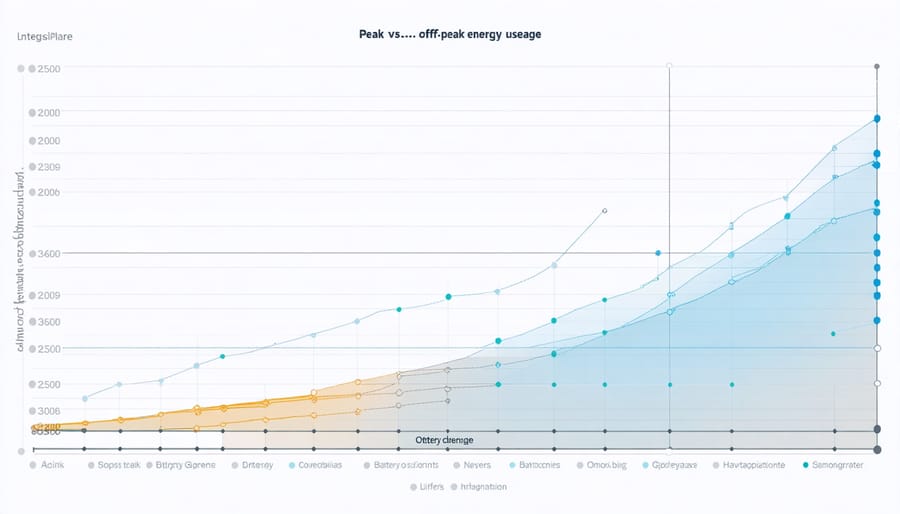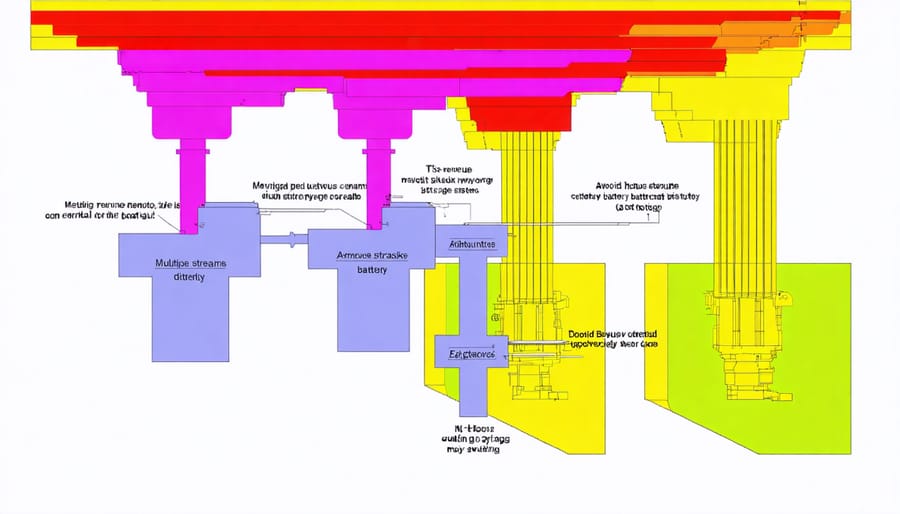Energy storage solutions have emerged as a pivotal force reshaping the modern energy landscape, offering businesses unprecedented opportunities to optimize costs and generate new revenue streams. As grid demands intensify and renewable integration accelerates, sophisticated energy storage systems are transforming from optional investments into strategic necessities. Forward-thinking organizations are capitalizing on multiple value streams – from demand charge reduction and energy arbitrage to grid services and resilience benefits – creating robust business models that deliver compelling returns. This shift represents more than just an operational upgrade; it’s a fundamental reimagining of how businesses can participate in and profit from the evolving energy marketplace. For facility managers and business leaders, understanding these emerging business models is crucial for maintaining competitiveness and capturing the full value potential of energy storage investments.
Current Energy Storage Business Models
Peak Demand Reduction
Peak demand reduction through energy storage represents one of the most financially compelling business models in the commercial energy sector. By strategically deploying battery systems, businesses can significantly reduce their utility demand charges, which often account for up to 50% of commercial electricity bills.
The process works by using stored energy during peak demand periods instead of drawing power from the grid. When electricity consumption spikes – typically during the afternoon in commercial buildings – the storage system automatically discharges to flatten the facility’s load profile. This peak shaving capability directly translates to lower demand charges on monthly utility bills.
For example, a 500kW/1000kWh battery system can reduce a facility’s peak demand by up to 30%, resulting in annual savings between $50,000 and $100,000, depending on local utility rates. The most successful implementations combine predictive analytics and automated controls to optimize discharge timing and maximize demand charge savings.
To implement an effective peak demand reduction strategy, businesses should analyze their load profiles, identify peak periods, and right-size their storage systems accordingly. Many organizations achieve ROI within 3-5 years through demand charge reduction alone.

Time-of-Use Arbitrage
Time-of-Use (TOU) arbitrage represents one of the most straightforward and effective ways to monetize energy storage systems. This strategy involves purchasing and storing energy during off-peak periods when electricity rates are low, then using or selling that stored energy during peak periods when rates are significantly higher. By enabling 24/7 power availability, facilities can optimize their energy consumption patterns and maximize cost savings.
The potential ROI from TOU arbitrage depends on several factors, including the price differential between peak and off-peak rates, storage system efficiency, and local utility rate structures. For example, in markets with substantial peak/off-peak price differences, businesses can achieve payback periods of 3-5 years through strategic energy shifting.
To implement successful TOU arbitrage, organizations should:
– Analyze historical electricity usage patterns
– Understand local utility rate structures
– Calculate optimal storage capacity requirements
– Implement automated control systems
– Monitor and adjust strategies based on performance data
Many commercial facilities have reported 15-30% reductions in electricity costs through well-executed TOU arbitrage strategies, making it a compelling business case for energy storage investment.

Revenue Streams from Grid Services
Frequency Regulation
Frequency regulation represents one of the most lucrative opportunities in the energy storage market, allowing businesses to generate revenue by providing grid stability services. This business model involves using battery systems to help maintain the grid’s frequency at its nominal value (50/60 Hz) by rapidly responding to supply-demand imbalances.
Energy storage operators can participate in frequency regulation markets by offering their battery capacity to grid operators, typically receiving payments based on both availability and performance. The revenue potential is particularly attractive because frequency regulation requires quick-response capabilities that battery systems are uniquely qualified to provide.
For example, a 10MW battery storage facility in PJM’s market can generate annual revenues between $200,000 and $400,000 through frequency regulation services alone. The exact revenue depends on market conditions, battery performance, and the facility’s operational strategy.
Key success factors include:
– Strategic positioning in markets with high regulation prices
– Advanced control systems for optimal response times
– Proper battery sizing to balance wear and tear with revenue potential
– Integration with other revenue streams like energy arbitrage
This model proves especially effective for commercial and industrial facilities that can combine frequency regulation with other energy management strategies, creating multiple revenue streams while supporting grid reliability.
Capacity Market Participation
Capacity market participation represents a significant revenue stream for energy storage operators, enabling them to profit by committing their storage resources to grid reliability services. Storage operators can bid their capacity into regional markets, guaranteeing availability during peak demand periods or grid emergencies in exchange for regular payments.
This business model typically involves entering into agreements with regional transmission organizations (RTOs) or independent system operators (ISOs), where storage operators commit to providing a specified amount of capacity when called upon. The revenue potential varies by market, with some regions offering payments ranging from $50,000 to $200,000 per MW-year.
For example, a 10MW battery storage facility in the PJM market earned $1.2 million annually through capacity commitments while maintaining the flexibility to participate in other revenue streams during non-dispatch periods. This demonstrates the stackable nature of capacity market revenues with other value streams.
To participate effectively, storage operators must:
– Meet minimum duration requirements (typically 4-6 hours)
– Maintain specified availability levels
– Respond within defined timeframes when called upon
– Navigate complex market rules and regulations
Success in capacity markets often requires sophisticated bidding strategies and careful consideration of degradation costs against revenue opportunities. Many operators partner with specialized market service providers to optimize their participation and maximize returns while managing operational risks.
Financing Options for Storage Projects
Third-Party Ownership Models
Third-party ownership models provide businesses with flexible options to implement energy storage systems without significant upfront capital investment. Under Power Purchase Agreements (PPAs), a third-party developer owns, operates, and maintains the storage system while the host facility pays for the stored energy services at predetermined rates. This arrangement typically includes performance guarantees and predictable energy costs over 10-20 year terms.
Lease arrangements offer another viable pathway, where businesses can utilize storage systems through fixed monthly payments. Operating leases allow companies to treat storage as an operating expense rather than a capital investment, while capital leases provide a pathway to ownership. Both models include maintenance and performance monitoring services from the provider.
These ownership structures help organizations overcome initial cost barriers while benefiting from reduced energy expenses and improved grid reliability. For example, a California manufacturing facility reduced its peak demand charges by 30% through a third-party operated 2MW storage system without any upfront costs.
When evaluating third-party options, businesses should carefully consider contract terms, performance guarantees, and exit clauses to ensure alignment with their long-term energy goals.
Direct Purchase ROI Analysis
Direct ownership of energy storage systems presents a compelling investment opportunity for businesses seeking long-term energy cost reduction and grid independence. The ROI analysis typically shows payback periods ranging from 5-7 years, with system lifespans extending to 15-20 years, creating substantial long-term value. To maximize energy ROI, organizations must consider several key factors: initial capital investment, ongoing maintenance costs, electricity rate structures, and peak demand charges.
Financial benefits include reduced utility bills through peak shaving, demand charge management, and time-of-use optimization. Additional value streams come from potential participation in grid services markets and enhanced power quality for sensitive operations. For a typical commercial installation, businesses can expect 15-30% reduction in annual electricity costs, with some achieving higher savings in regions with favorable rate structures.
Organizations should conduct comprehensive site-specific analyses, considering factors such as load profiles, local utility rates, and available incentives. This approach ensures accurate ROI projections and optimal system sizing for maximum financial returns.

Case Study: Successful Commercial Storage Implementation
The Pacific Gateway Industrial Park in Southern California demonstrates one of the most successful commercial energy storage implementations to date. In 2019, the facility installed a 5MW/20MWh battery storage system integrated with their existing solar array, resulting in remarkable financial returns and operational benefits.
The project’s success stems from a multi-revenue approach that combines demand charge management, energy arbitrage, and grid services participation. The facility reduced its peak demand charges by 42% in the first year of operation by strategically discharging stored energy during high-demand periods. This alone resulted in annual savings of $380,000.
The storage system enables the facility to purchase and store electricity during off-peak hours when rates are lowest, typically between midnight and 6 AM, and use this stored energy during peak periods when rates can be up to three times higher. This energy arbitrage strategy generates approximately $250,000 in additional annual savings.
Furthermore, the facility participates in the local utility’s demand response program, earning revenues by providing grid stability services. In 2020, the system generated $175,000 through demand response participation while maintaining regular operations without disruption.
The initial investment of $4.2 million was offset by a combination of federal tax incentives, state rebates, and utility incentives, reducing the net cost to $2.8 million. With combined annual benefits exceeding $800,000, the project achieved a payback period of just 3.5 years, significantly outperforming initial projections of 5 years.
Key success factors included:
– Comprehensive energy usage analysis before implementation
– Strategic sizing of the storage system based on demand patterns
– Integration with existing energy management systems
– Staff training and optimization of control algorithms
– Regular performance monitoring and adjustment
The facility’s management reports additional benefits, including improved power quality and enhanced resilience against grid outages. The success has prompted the industrial park to plan a phase two expansion, doubling storage capacity to capture additional revenue opportunities.
This case study demonstrates how commercial storage installations can create multiple revenue streams while improving operational efficiency and grid reliability. The project’s success has become a model for other industrial facilities looking to implement similar energy storage solutions.
Successful implementation of energy storage solutions requires careful consideration of multiple factors to ensure profitability and long-term sustainability. Business owners and facility managers must first assess their specific energy needs, consumption patterns, and local market conditions to determine the most suitable storage model. The choice between behind-the-meter applications, grid services, or hybrid approaches should align with both operational requirements and revenue optimization goals.
Financial success in energy storage ventures depends heavily on selecting appropriate revenue streams and optimizing system operation. Organizations should consider stacking multiple value streams, such as demand charge reduction, energy arbitrage, and ancillary services, to maximize return on investment. Additionally, careful attention must be paid to system sizing, technology selection, and maintenance requirements to balance capital costs with expected returns.
Regulatory compliance and utility engagement remain crucial elements for sustainable energy storage business models. Organizations should maintain open communication with utilities and stay informed about evolving energy policies and incentive programs. Partnership opportunities with energy service providers, technology vendors, and financial institutions can help mitigate risks and enhance project viability.
Looking ahead, the energy storage market continues to evolve with improving technologies and decreasing costs. Organizations that establish flexible, scalable business models while maintaining strong operational practices will be best positioned to capitalize on emerging opportunities in this dynamic sector. Success ultimately depends on developing a comprehensive strategy that addresses technical, financial, and regulatory considerations while remaining adaptable to market changes.

